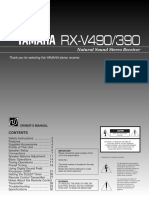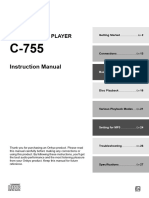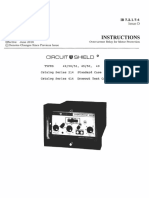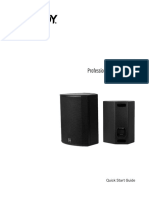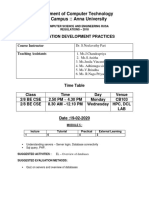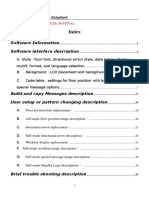T 407owners
T 407owners
Uploaded by
Aleksandar BilakCopyright:
Available Formats
T 407owners
T 407owners
Uploaded by
Aleksandar BilakOriginal Title
Copyright
Available Formats
Share this document
Did you find this document useful?
Is this content inappropriate?
Copyright:
Available Formats
T 407owners
T 407owners
Uploaded by
Aleksandar BilakCopyright:
Available Formats
T-4OT
Quarlz Synthesized FM Stereo/AM Tuner
o Congratulations on your purchase of the ONKYO T-407 Tuner. . Please read this manual
thoroughly before making connections and turning power on. . Following the instructions
in this manual will enable you to obtain optimum performance and listening enjoyment from
your new T-407, o Please retain this manual for future reference.
CONTENTS
Features.. 1
lmportant safeguards 1
2
Supplied accessories 2
System connect¡ons ................. 2
Front panel facilities 4
Operations 5
Trouble-shooting 9uide........... 7
Specif ications 7
Features
a lsohex Power Supply
ONKYO's exclusive lsohex Power Supply arranges the six ma¡n tuner circuits like the spokes of a wheel around a central power supply
hub. lndependentsupplyandgroundlinesrunfromthepowersupplytoeachofthetunercircuits:tothedisplay,tothequartzsynthesizer,
to the front end, to the lF, to the FM PLL demodulator. and to the stereo MPX. By minimizing the distance between the power supply
and each circuit, this arrangement improves power supply control. By isolating the routes to the circuits, it also avoids interference.
. Outstanding Sensitivity and Tuning Precision
One ma.jor reason for the T-407's excellent sensitivity and tuning precision is its RF section which uses five varactor diodes "ganged"
through the single tun¡ng voltage sorrc". ihis uncompromising design, coupled with MOS FETs and a dual local oscillator buffer, gives
the T-407 the sharp, precise reception listeners expect from an ONKYO tuner.
. O-Station FM/AM Random Preset Tuning
. Classified Memory Preset
On the T-407 the memory presets are organized into eight classes designated A-H. Each class can be assigned to a different type of
program material or a different member of the family. You can preview the stat¡ons in any particular class at the touch of a button.
o Direct Access Tuning
lnstead of using the UP or DOWN tuning keys to scan through the available frequencies until the desired station is located, Direct Access
Tuning lets you punch in the broadcast frequency directly using the 10 numeric keys. For example, to select 103.5 MHz the user simply
presses the 1, 0, 3, 5 and 0 keys.
. APR (Automatic Precision Reception) System
a Naming stat¡ons using 5 characters, 40 stations in total
o Front End Designed to Minimize lntermodulation Distortion
o 25 kHz FM Tuning Steps
o 10-Segment Sígnal Strength lndicator
. l:ll Remote Control System Compatible
I
CAUTIO N: "WARN ¡NG"
"TO REDUCE THE RISK OF ELECTRIC SHOCK, DO NOT REMOVE "TO REDUCE THE RISK OF FIRE OR ELECTRIC SHOCK, DO NOT
COVER (OR BACK). NO USER.SERVICEABLE PARTS INSIDE. EXPOSE THIS APPLIANCE TO BAIN OR MOISTURE."
REFER SERVICING TO OUALIFIED SERVICE PERSONNEL."
a For models having power cord wlth a polarized plug.
o
w CAUTION
The líghtning flash with arrowhead symbol, w¡thin
CAUTIO N:
TO PREVENT ELECTRIC SHOCK,MATCH WIDE BLADE OF PLUG
TO WIDE SLOT, FULLY INSERT.
an equilateral triangle, ¡s intended to alert the user
to the presence of un¡nsulated "dangerous voltage"
o Sur les modèles dont la fiche est polarisée.
within the product's enclosure thât may be of suffi- ATTENTI O N:
c¡ent magnitude to cçnstitute a risk of electric shock POUR EVITER LESCHOCS ELECTRIOUES, INTRODUIRE LALAME
to persons. LA PLUS LA.BGE DÊ LA FICHE DANS LA BORNE CORRESPONDANTE
DE LA PRISE ET POUSSER JUSOU' AU FOND.
o The exclamation point within an equilateral triangle
is intended to alert the user to the presence of im-
portant operal¡ng and maintenance (servicing) in-
structions in the literature accompany¡ng the appli-
ance.'
13. Cleaning - The appliance should be cleaned only as recommended
lmportant uards by the manufacturer.
14. Power Lines - An outdooor antenna should be located away from
power lines.
1. Read lnótructions - All the safety and operat¡ng ¡nstructions
should. be read before the appliance is operated. 15. Nonuse Periods - The power cord of the appliance should be
2. Retain tnstruct¡ons - The safety and operating instruct¡ons unplugged from the outlet when left unused for a long period of time.
should be retained for future reference. 1 6. Object and Liquid Entry - Care should be taken so that obiects
3. Heed Warníngs - All warnings on the appliance and in the op- do not fall and liquids are not spilled ¡nto the enclosure through
openings.
erating instructions should be adhered to.
4. Follow lnstruct¡ons - All operating and use instructions should 17. Damage Requiring Service - The appliance should be serviced
be followed. .
by qualified service personnel when:
A. The power-supply cord or the plug has been damaged; or
5. Water and Moisture - The appliance should not be used near B. Ob¡ects have fallen, or liquid has been spilled into the appliance;
water - for example, near a bathtub, washbowl, kitchen sink, laundry or
tub, in a wet basement, or near a swimming pool, and the like. C. The appliance has been exposed to ra¡n; or
6. Carts and Stands - The appliance should be used only with a
D. The appliance does not appear to operate normally or exhibits a
can or stand that ¡s recommended by the manufacturer. marked change in performance; or
E. The appliance has been dropped, or the enclosure damaged.
64. An appliance and cart combination
should be moved wilh care. Ouick stops, PORTABLE CABT WARNING 18. Servicíng - The user should not attempt to serv¡ce the appliance
excessive force, and uneven surfaces beyond that described ¡n the operat¡ng instructions. All other servicing
may cause the appliance and cart should be referred to qualified service personnel.
combination to overturn. 19. Outdoor Antenna Grounding - lf an outside antenna is conneded
to lhe receiver, be sure the antenna system is g rounded so as to prov¡de
some protection against voltage sufges and builþup stat¡c chãrges. Article
810 of the National Electrical Code, ANSI/NFPA 70, prov¡des inlormation
s31 25A w¡lh regard to proper ground¡ng of the mast and support¡ng structure,
grounding of the lead-in wire to an antenna discherge un¡t, size of ground-
ing conductors, location of the antenna.discharg( unit, connection to
ground¡ng electrodes, and requ¡rements for lhe ground¡ng electrode. See
7. Wall or Ceiling Mounting - The appliance should be mounted Figure 73.1.
to a wall or ceiling only as recommended by the manufacturer.
8. Ventilation - The appliance should be situated so that its location FIGURE 73.1 :
or position does not interfere with its proper vent¡lation. For example, EXAMPLE OF ANTENNA GROUNDING AS PER NATIONAL
the appl¡ance should not be situated on a bed. sofa, rug, or sim¡lar ELECTRICAL CODE
suÌface that may block the ventilation openings; or, placed ¡n a bu¡lt-¡n
installation, such as a bookcase or cabinet that may ¡mpede the flow
of air through the ventilation openings.
9. Heat - The applianceshould besituated awayfrom heatsourcessuch
as radiators, heat registers, stoves, or othér appl¡ances (including ANTENNA
LEAD IN
amplifiers) that produce heat. WIRE
10. Power Sources - The appliance should be connected to a power
GROUND
supply only of the type described ¡n the operating instructions or as CLAMP
marked on the appliance.
11. Polarization - lf the appliance is provided a polarized plug having ANTENNA
OISCHARGE UNIT
on blade wider than the other, please read the follow¡ng information; (NEC SECTTON 810-2O)
' The polarization of the plug is a safety feature. The polarized plug
w¡ll ELECIRIC
only fit the outlet one way. lf the plug does not fit fully ¡nto the outlet, SERVICE
try reversing it. lf there is still trouble, the user should seek the sery¡ces EOUI PM ENT
GROUNDING CONDUCTOBS
of a qualified electrician. Under no circumstances should the user at- (NEC SECTTON 810-21)
tempt to defeat the polar¡zation of the plug. GBOUND CLAMPS
12. Power-Cord Protection - Power-supply cords should be routed POWER SERVICE GROUNDING
ELECTRODE SYSTEM
so that they are not l¡kely to be walked on or p¡nched by items placed (NEC ART 250, PART H)
upon or against them, paying particular attent¡on fo cords at plugs, NEC NATIONAL ELÊCTRICAL CODE
-
convenience receptacles, and the point where they exit from the ap-
s2898A
pliance.
Precautíons
Warranty Card 2. Care
The serial number is written on the rear panel of th¡s unit. Copy From time to time you should wipe off the front and rear panels
the serial number and model number onto your warranty card and the cabinet with a soft cloth. For heavier dirt, dampen a soft
and keep it in a safe place. cloth in a weak solution of mild detergent and water, wring it
out dry, and wipe off the dirt. Following this, dry immediately
with a clean cloth. Do not use rough material, thinners, ¿lcohol
or other chem¡cal solvents or cloths since these could damage
the finish or remove the panel lettering.
Supplied Accessories
fi|l remote control cable x1 Output signal cord x 1
AM loop T-shaped FM Antenna
antenna x 1 anlenna x 1 adapter x 1
FM Antenna Connections
Sysitem connectÍons Depending on the strength and quality of FM signals in your area,
the accessory T-shaped antenna may give satisfactory reception
a Do not connecl the power cord until all other connections have or you may need an exlernal FM antenna. To use the T-shaped
been made. antenna, òpread rhe antenna on a wall, preferably outside or on the
ceiling, and try several positions to determine which gives the best
Outdoor reception. lf reception with the T-shaped antenna is unsatisfactory,
FM antenna
Indoor T-shaped install a mulli-element external FM antenna. Consult your ONKYO
300 Ohm FM feeder or
anlenna Outdoor Service Center about the right type for your area.
AM Loop antenna AM antennâ
75 Ohm NOTES:
(3C-2V,
1. Do not use the same antenna for both FM and TV (or VCR)
Connecl only one reception since the FM and TV (or VCR) signals can interfere
FM antenna at with each other. lf you must use a common FMiTV (or VCR)
one t¡me
antenna, use a directional linkage type splitter.
2. Follow the direct¡ons below 10 connect an antenna adapter
to a 75 Ohm cable.
. tothe Rl remolecontroljack 3. Do not connect both the indoor T-shaped antenna and an
Do nol connecl any producl 1o
outdoor FM antenna. lf you decide to install an outdoor
th¡s jack that does nol have the
ONKYO Rl mark. antenna, be sure to d¡sconnect the indoor T-shaped antenna'
. The upper and lower fil I re-
mote control jacks have ths
same function.
o [öl
o 9,e @ LAJ
To Amplifier
AC Power
When connscting tuner output to the âmpl¡f¡er Direct¡onal l¡nkage
Supply
be åbsolulely sure to connect the R (right) type splitter
and L (left) channels correctly.
To ¡uner To TV (or VCR)
Note to CATV system installer:
This reminder is provided to call the CATV system installer's atten-
AM loop antenna assembly
tion to Arlicle 820-40 of the NEC, which provides gu¡delines tor
proper grounding and, in particular, specifies that the cable ground
Connecl to rhe AM
shall be connected to the grounding system of the building' as close antenna term¡nals.
to the point of cable entry as practical.
o @ @
How to connect a75l?OO Ohm antenna adapter
(included) E E
I Connecting coaxial cable Remove the v¡nyl tie and
(1)With your fingernail or a small screwdriver. press the tâke oul th€ connecl¡on
Bend in the reverse
stopper inwards and remove the cover. line.
direction.
(2)Prepare the coaxial cable as shown below.
(3)Connect the 75/300 Ohm antenna adapter to the coaxial
cable @
(2\
a. Wirh rhe antenna on
top of any stable surlaca
+
+ tRG-6
Mount
(3) @ lnssn lh6 end of the cable.
@ Remove rhe red cord.
b. With the antenna
attached to a wall
75l300 Ohm
&*A- ,q,
antenna
adapter
(included)
Clamp in place wirh Pl¡e6. lnstallation hol€
Mount on a wall, elc.
I Connecting T-shaped FM antenna or 300 Ohm FM
outdoor antenna
-,/ -æ
-./-- AM Antenna Connections
é,.- É,llll FM/rv An AM loop antenna is included in the installation inslructions bag'
Outdoor Take out the connection line and connect it to the AM antenna
J[
"nr"nn" terminals. This loop antenna can be used placed on top of the luner
300 Ohm or attached to a wall or other surface. Try several positions to
foedar
determine which gives the best recept¡on. Be. sure the antenna is
not near a speaker, power cord, television set, VCR. or molorized
appliances. When using an external AM antenna, do not remove
the loop antenna; connect both antennas to the AM antenna ter-
minals.
l:lt Remote Control jack ( Rl : Remote lnteractiv-e) Memory Preservation
For remote control opeiation, connect th¡s jack and any ONKYO This unit does not require memory prese¡vat¡on batteries. A
amplifier bearing the " |lll " mark using the remotecontrol cable built-in memory power back-up system preserves the contents
includêd with th¡s unit.(Station Up/Down buttons can be controlled of the memory during power failures and even when the unit
via remote control.) For more details, see the user's manual for the is unplugged. The unit must be plugged in and the power switch
amplifier. turned on and off once in order to charge the back-up system,
Note that since this is not a permanent memory, the power switch
NOTE
must be turned on and off a few times each month to keep the
The Rl mark is ONKYO's own mark. Audio equipment with back-up system operative.
this mark can be controlled through the amplifier with the The memory preservation period after power has been turned
Rl mark. using remote control transmitter. Do not çonnect off varies depending on climate and placement of the unit. On
any product to this jack that does not have the ONKYO |:ll the average, memory contents are protected over a period of a
mark. Doing so can damage your equipment. few weeks after the last time power has been turned off. This
period is shorter when the un¡t is exposed to a highly humid
climate.
Front panel facÍlíties
Front panel
For more information about buttons or controls, turn to the page number listed in the [ ]
Number buttons
(1-9. 0)
Tuning Selector/Character Search Buttons
(<DOWN UP>) [5,6]
Power Switch (POWER) Direct Tuníng Button
Depress once to turn power on and once (DTRECT) [5]
again to turn power off. Preset Scan Button
Band Selector Buttons (FM, AM) (scAN) t6l
t51
æ fæEEf@fr€
t:@æt:::@c6: îi I tiÑt
APR ON Button Character Memory Button
(APR OPERATION) Tuning Level Selector Button
(TUNTNG rEVEL) [5] (cHARACTER) [6]
I6I
lF Bandw¡dth Selector Button Display Button (DISPLAY) [6]
(rF BAND) [6] RF Mode Selector Button
(RF MODE) t5I Memory Button
Hi-Blend Selector Button (MEMORY) t5l
(Hr-BLEND) t6l
Classified memory buttons FM Tuning Step/Muting Button
Auto Stereo/Mono Selector Button (CLASS A CLASS H) t5l (cABLE/MUTE) [5]
(MODE) 16l -
Display and indicators
Frequency and Character Display Classified Memory
Display
Signal Strength lndicator
APR system indicators Stereo lndicator Memory lnd¡cator
I t-tl trt óB
I tNt MH¿ U CH
FM Tuning Step/Muting lndicator
Classified Preset Station/Tuning Level Display
Operations
. Before tutning the power on, confirm that all connections have been made properly.
o All buttons on this.un¡t (except the power sw¡tch) are soft-touch buttons. When the power is turned on, all settings return to the same
ones set when power was last turned off.
I RF mode, DX or LOCAL (FM only)
DX mode should be used when receiving a weak signal from a
FM, AM DIRECT TUNING farawaystation.
While LOCAL mode should be used when receiving a strong
signal from a nearby stat¡on.
When tuning, using either the tuning buttons or the number
burtons, w¡th the APR button engaged, the RF mode will change
automat¡cally to DX mode.
lf LOCAL mode is required, press the RF mode button to switch
from DX mode.
I FM Stereo lndicator
This indicator lights when an FM broadcast is being received.
TUNING LEVEL - DOWN, UP- It does not light when a weak FM stereo broadcast ¡s being
received,
lf you want to listen to an FM broadcast in MONO mode, press
the MODE button to turn the Stereo lndicator off.
I Tuning w¡th the tuning buttons I To achieve more precise tuning of a cable broadcasting
To tune in an FM or AM station not stored in the memory, press station when receiving a cable FM (TV) broadcast
the Tuning selector buttons. lf you press UP, RF mode'changes Use the UP or DOWN button to approximately locate the
to DX and the frequency is increased. Pressing DOWN decreases broadcastin.g. frequency in 50 kHz sleps, then use the
the frequency. Note that the frequency is changed in 50kHz steps CABLE/MUTE button to turn off FM muting and set the tuning
in FM and 9/1OkHz steps in AM when the Tuning selector step to 25 kHz. The IEABLEIindicator will light up so that manual
buttons is pressed in single steps. lf this button is pressed tuning of the broadcasting frequency can be performed using
continuously for more than 0.5 second, aulo tuning mode is the tun¡ng seleclor button. During 25 kH.z tuning step mode,
entered, and frequencies are scanned automatically. When a automatic tuning is disabled. The conditions picked up during
broadcast signal is rèceived, scanning stops. lf a differenl fre- this Tuning Step Mode can be placed in memory.
quency is desired, press the button once again. NOTE:
a Scann¡ng will not stop for broadcasts weak enough to be When the CABLE mode is cancelled, the tun¡ng frequency re-
suppressed by the muting circuit. To receive a weak FM
turns to 50 kHz step mode.
broadcast, set the CABLE/MUTE button to the position the
Examples: 100.125 + 100.100 MHz
CABLE indicator is on, and select the frequency of the desired
' 100.t75 + 100.150
broadcast stat¡on in single steps.
100.100 + 100.100
I Using the TUNING LEVEL button (FM only)
Each time this button is pressed, the auto tuning level is alter- I Receiving a stat¡on by inputting the frequency for the
nately set to 20 dB or 35 dB. Use the 35 dB setting if there are stat¡on d¡rectly (Direct Tuning)
a lot of strong FM broadcasts in your area, and the 20 dB setting lf the frequency for the desired station is known, input the fre-
if there are a lot of weak FM broadcasts in your area. The current quency number directly.
setting is shown in the multi function display for about two @ Press the AM or FM button.
seconds each time this selector is pressed. To receive broadcasts @ Press the DIRECT TUNING button.
below the level of 20 dB, set the CABLE/MUTE button to light . "-" will flash for 16 seconds in the Frequency Display.
up CABLE indicator and tune. The displayed tuning level unit @ tnput the desired frequency number by using the Number
of 'dB' is an abbreviation for dBf. Buttons while the cursors are flashing. For instance, if you
I wish to receive the station of 88.10MH2, press the Number
Signal Strength lndicator
Buttons, 8, 8, 1 and 0.
Optimum tuning points are indicated by the number of lighted
segments. i o ln areas where AM frequencies are set in 1 okHz steps,
inputting a number to the 10kHz digit sets 0 1o the l kHz
cligit automatically.
a lf the desired frequency set in fhis operation does not exist,
SIGNAL STRENGTH the frequency which is the nearest and lower than the desired
10 .5p. 100
frequency will be received. lf the frequency set is not ¡n the
ililililililil receive frequency range, the frequency flashes for two sec-
onds and then the previous frequency will be displayed.
. lf awrong frequencyhas been set, pressthe DIRECTTUNING
button and start aga¡n.
I How to classify and memorize stat¡ons @ Press the MEMORY button.
The memory can be divided (classified) for different users or o The MEMORY ind¡cator will flash for 8 seconds.
programs of stations. @ Press the desired Classified Memorybutton (one of buttons
W¡th this model, eight classes (CLASS A to H) are available A to H).
and stations can be memorized in any class. Atotal of 40stations a The stat¡on is memorized in the selected class with the
can be memorized in classes from A to H. Although the same memory number which is the smallest of the unoccupièd
station can be memorized in different classes, the memory numbers in the class.
number for the3tation will differ depending on the order in which By repeating the operations above, up to 40 stations can be
the station is memorized in the classes. memorized. lf an attempt is nrade to memorize 41 stations,
@ Tune in the desired station (see previous section on the "FULL" will be displayed in the Frequency Display, indicating
tuning operations). that no more stât¡ons can be memorized.
I How to cancel memorized stat¡ons c. Press the SCAN button
Retrieve the class number you want to cancel (see "How to o Stat¡ons memorized in the present class will be
retrieve.memorized stations") and then press the Dl RECT button scanned in a order and the corresponding memory
while holding down the MEMORY button. Another station can number will flash in the Preset station display at each
be memorized with the memory number which has beén can- scan. After the last memory number of the class is
celled. reached, scanning starts again from the first memory
number of the class. Pressing the SCAN button again
I How to retrieve memorized stat¡ons
button for the desired class. stops scanning.
@ Press the Classified Memory
o The memory number (station) which was last used in the
. Pressing the SCAN button after pressing the MEM-
ORY button, enables you to scan through the memory
class will be received.
There are sovoral methods to proceed after the above opor- numbers in all the classes one by one.
@
ations are carried out. Use any of the following methods. I APR (Automat¡c Precision Reception) System (FM only)
a. Pressing the same Classified Memory button again per- This unit is equipped with ONKYO's unique APR system that
mits the next preset memory number (station) lo be re- automatically controls the Auto stereo/Mono reception modes,
ceived. lF bandwidth wide/narrow setting and FM auto hi-blend circuit
b. lnput the memoiy number you wish to receive by using according to the quality (signal strength, distortion, etc.) of the
the Number buttons. signal currently being received. Consequently, optimum re-
o lf the memory number consists of 2 digits, input two ception (the lowest distortion and highest S/N ratio) is assured
numbers, immediately one after the other. For instance, at all times. Note that the APR system functions only during
when inputting "15", "15" will not be registered if FM reception. An Auto Stereo/Mono Selector, lF bandwidth
you wa¡t more than one second before inputting "5", selector and auto hi-blend selector are provided to allow man-
resulting in only "1" being registered. ually overriding these three APR controlled reception modes.
a lf a number other than a number from 1 to 40, or a lf the station is retuned, or the APR button is pressed again
number which has not been memorized is input, the however, the or¡ginal APR selected modes will be restored.
number flashes for 2 seconds and then the number The APR system functions automatically when using the UP
which was displayed before will be displayed. or DOWN .buttons, or direct tuning.
. lf a number between 1 and 4 is pressed, the display The APR settings are memorized when the station is memorized.
and station are changed 1 second later.
I How to name preset stat¡ons
(Character memory function)
This function enables you to memorize a maximum of 5 char-
acters consisting of alphabetics, some symbols and numbers, n 1'; IIE F E l-1 I ,-l i-( l- l'l l"l Ü
for instance, representing broadcasting station names, for each t-t nt-t TTttt/tt\/t/-7 l-t ll:J
ttt!/ l/\l /\ t / U t_-l:_t
preset station. f-LlfiJ
,l',a E -ii7 ri ,' )K -f I tl / \ !)
. DOWN /UP -
@ Press the CHARACTER button once more when the desired
character is displayed. The character will be memorized and
the cursor moves to the next character.
E ÞE
I
I
CLASS I\ ø@ DISPLAY o Select 5 characters by repeating steps @ and @ . lf you
want to include a space, press the CHARACTER button.
CHARACTER @ Press the CHARACTER button after selecting 5 characters.
The display shows an FM broadcast at 105.11 MHz has been ä,,iääirifräi"""'-1" llt',i t( \' tl..:". l? t""
memorized in 1 CH of the CLASS A, and hat been named
"oNKYO".
o Flashing stops, and the naming operation is complete.
@ Call up the stat¡on to be named, using the CLASS A Button. I How to change the character
a lf the bröadcast has not yet been memorized in the preset Press the CHARACTER button to flash the character and select
station, see Page 5. the desired character using the UP > and DOWN < buttons.
I How to delete all characters at once
Press the DISPLAY button, while holding down the CHAR-
ACTER button.
@ Press the DISPLAY button.
a The frequency in the display goes off and the cursor I How to use the DISPLAY button
flashes at the first character. When characters are memorized for a preset slation, pressing
the CLASS Button does not display the frequency, but the
characters.
Press the DISPLAY button if you wanï to display the frequency.
@ Select a character using the UP > or DOWN < button
NOTE:
while thè cursor is flashing (approx. 5 seconds).
o The characrer changes lrom " f-f " to " -_il ", " | " ana lf you press DISPLAY once, and the wrong characters appear,
press the button twice more: once to display the frequency, then
so on when pressing the UP I buttonland changes in
once more to display the correct character sequence.
reverse order when pressing the DOWN I button.
o Press the DISPLAY button once more if the cursor stops
f lashing.
T roub,le-shaotÍ ng guide
Troubte Cause Remedy
No power o Power cord is disconnected. o Connect power cord
Buzzing noise on AM, usually conspicu- a Noise from electrical apparatus such o Move set to d¡fferent location.
ous at night or with a weak station. as fluorescent lamps. a Change the position or direction of the loop an-
tenna.
Hiqh pitch noise. o Noise from TV o Keep unit away from TV set.
Crackling noise on AM and FM. o Noise caused by turning fluorescent o Move the antenna as far away as possible from
lamp on and off. the fluorescent lamp.
. Noise from automobile ignition. a lnstall an outdoor FM antenna as far away as
possible from the road.
AM stations cannot be received o AM loop antenna is not attached a Connect the included AM loop antenna to the
AM antenna terminals.
FM signal strength indicators and stereo o Stat¡on is too strong. a Change to T-shaped antenna.
indicalor light but sound is d¡storted and a Multiple reflection of the radio waves o Use antenna which has better directivity and se-
seDarat¡on is bad. because of tall buildinss or mounta¡ns. lect a point where the distortion is.least.
FM signal strength indicators and stereo a Station is too weak. a lnstall an outdoor FM antenna.
indicalor flicker and hiss is heard on FM. a Stereo FM broadcasts cover only about o Change the position or direction of the outdoor
half the distance of an ordinary antenna.
broadcast.
No station or undesired stat¡on ¡s recalled o The Power switch has not been turned a The memory contents are lost if the power is not
when a Preset button is pressed. on for a long time, or the power cord turned on and off a few times each month. Store
has been unplugged for a long time. . .all stations in the memory again and remember
to turn power on and off a few times each month.
The tuning steps by which the tuned frequency increases/decreases have been set at the factory to the proper value for the area where each
unit is to be sold. lf you use the unit in a country where a different tuning step is required or if the broadcast frequencies in your country
change so that you can not tune in radio stations precisely, contact your ONKYO authorized service center.
SpecÍfications
FM: AM:
Tuning Range: 87.50 - 108.00 MHz Tuning Range: 530 - 1710 kHz (10 kHz steps)
(50/25 kHz steps) Usable Sensitivity: 25 ¡tV
Usable Sensitivily: Mono: 10.8 dBf,0.95 pV,75 Ohms IHF lmage Rejection Ratio: 40 dB
(75 Ohms IHF) lF Rejection Ratio: 40 dB
Stereo: 17.2 dBf , 2.0 ¡tV, Signal-to- Noise Ratio: 40 dB
(75 Ohms IHF) Total Harmonic Distortion; o.70/o
50dB Ouieting Sensitivity: Mono: 16.1 dBf, 1.7 pV (75 Ohms) Output Voltage: 150 mV
Stereo: 36.1 dBf, 17 pV (75 Ohms)
General
Capture Ratio: 1.3 dB (Wide)
Power Supply: AC12OV,60 HZ
lmage Rejecrion Ratio: 90 dB
lF Bejection Ratio: 90 dB
Dimensions(W xHx D) 455 x 90 x 364 mm
Signal-to- Noise Ratio: Mono: 85 dB, IHF (17-15/16" x3-5/8" x 14-5l16")
Weight: 4.8 ks 10.6 lbs.
Stereo: 80 dB, IHF x
Supplied accessories: AM loop antenna 1
Alternate Channel
FM T-shaped antenna x 1
Attenuation: 50 dB IHF (*400 lHz) (Narrow)
Connecting cable x 1
AM Suppression Ratio: 50 dB
Rl remote control cable x 1
Total Harmonic Distortion Mono: 0.1% (Wide)
75/300 Ohm antenna adapter x 1
Stereo: O,2o/o (\trtlide)
Frequency Response: 30 - I5,000 Hz +0.5 -1.0 dB
Stereo Separation: 45 dB at 1 kHz (Wide)
30 dB at 70 - 10,000H2 (Wide),
Output Voltage: 0.5 v
Muting Level: 17.2 dBf , 2.0 pV (75 Ohms)
Specifications and features are subject to change without notice.
ONITYO CORPORATION
lnternational Division: Onarimon Yusen Bldg., 23-5, Nishi-Shimbashi 3-chome, Minato'ku,
TOKYO 105, JAPAN Tel: 03-3432-6987 Fax: 03-3436-6979
ONKYO U.S.A CORPORATION
200 Williams Drive, Ramsey, N.J.07446, U.S.A.
Tel: 201-825-7950 Fax: 20'l-825-8150
l¡
-=r
You might also like
- Hfe Onkyo Ht-r560 enDocument96 pagesHfe Onkyo Ht-r560 enKeith GruberNo ratings yet
- Onkyo HT-R430 Reciever User ManualDocument56 pagesOnkyo HT-R430 Reciever User ManualYoudont Knowme33% (3)
- Onkyo Onwer's Manual TX-SR803 703 PDFDocument96 pagesOnkyo Onwer's Manual TX-SR803 703 PDFVidiNo ratings yet
- Online Shopping SystemDocument21 pagesOnline Shopping SystemAnuj Kumar Singh50% (2)
- A6V10210424Document214 pagesA6V10210424doruman100% (2)
- 2 Way Switch (3 Wire System, New Harmonised Cable Colours) - Light WiringDocument3 pages2 Way Switch (3 Wire System, New Harmonised Cable Colours) - Light WiringamithkmNo ratings yet
- 7.1ch Home Theater System: AV Receiver (HT-R560) Speaker Package (HTP-560)Document96 pages7.1ch Home Theater System: AV Receiver (HT-R560) Speaker Package (HTP-560)Comercio ExpressNo ratings yet
- HT-SR800: 7.1ch Home Theater SystemDocument72 pagesHT-SR800: 7.1ch Home Theater SystemsimpliceNo ratings yet
- ONKYO tx-sr307Document72 pagesONKYO tx-sr307popNo ratings yet
- HT-S7300 HT-S6300: 7.1ch Home Theater SystemDocument76 pagesHT-S7300 HT-S6300: 7.1ch Home Theater SystemMarcelo AlmeidaNo ratings yet
- Onkio txsr707Document128 pagesOnkio txsr707Drazen HajlingNo ratings yet
- Onkyo TX-SR804 User ManualDocument96 pagesOnkyo TX-SR804 User ManualicatsNo ratings yet
- htx22hd Instruction ManualDocument76 pageshtx22hd Instruction ManualFedericoNo ratings yet
- TXSR 705Document162 pagesTXSR 705Daniel PadovaniNo ratings yet
- TX sr607Document108 pagesTX sr607sarath chandranNo ratings yet
- Marantz PM-7000 User GuideDocument17 pagesMarantz PM-7000 User Guidepeter11No ratings yet
- Onkyo TX-SR600 Instruction ManualDocument80 pagesOnkyo TX-SR600 Instruction Manualkuko61No ratings yet
- Onkyo Home Theater Receiver TX-SR504 - BDocument80 pagesOnkyo Home Theater Receiver TX-SR504 - BOaryon Nox LaihoNo ratings yet
- Manual Onkyo HT-r540Document80 pagesManual Onkyo HT-r540moreno.schroederNo ratings yet
- Manual Onkyo TX-SR304Document60 pagesManual Onkyo TX-SR304Ricardo PreciosoNo ratings yet
- Vestax Pmc170a ManualDocument12 pagesVestax Pmc170a ManualjnglmsvNo ratings yet
- Pioneer VSX 511s ManualDocument48 pagesPioneer VSX 511s ManualJulioCezarVassãoNo ratings yet
- SKS-HT530: 7.1ch Home Theater Speaker PackageDocument32 pagesSKS-HT530: 7.1ch Home Theater Speaker PackageJaime GarayNo ratings yet
- TX-nr807 Manual eDocument148 pagesTX-nr807 Manual eBrian KuusNo ratings yet
- YST-SW150/80: Thank You For Selecting This YAMAHA Subwoofer SystemDocument12 pagesYST-SW150/80: Thank You For Selecting This YAMAHA Subwoofer SystemDjParaNo ratings yet
- Onkyo c-705tx CD Player User ManualDocument24 pagesOnkyo c-705tx CD Player User ManualNilo BrasilNo ratings yet
- Acoustic Box 2 ManualDocument17 pagesAcoustic Box 2 ManualAdedejinfoNo ratings yet
- Yamaha RV 501 Owners ManualDocument31 pagesYamaha RV 501 Owners ManualJavier ValenzuelaNo ratings yet
- Yamaha RXV 390 Owners ManualDocument31 pagesYamaha RXV 390 Owners ManualGabriel EstrellaNo ratings yet
- ht-s590 Manual e PDFDocument60 pagesht-s590 Manual e PDFGabriela Burcea-BlendeaNo ratings yet
- Manual t1055 Clarity II Turbidimeter Rosemount en 69022Document68 pagesManual t1055 Clarity II Turbidimeter Rosemount en 69022Carlos HenriqueNo ratings yet
- ManualDocument12 pagesManualmarketingcmgaliciaNo ratings yet
- HTs5200 User ManualDocument92 pagesHTs5200 User ManualJose Luis GutierrezNo ratings yet
- Akai Lct32ad Lct32ha36 SMDocument136 pagesAkai Lct32ad Lct32ha36 SMMarius FilonNo ratings yet
- RP 29fa40 Chassis FaDocument57 pagesRP 29fa40 Chassis FacarcegarNo ratings yet
- Manual C 755 enDocument28 pagesManual C 755 enJerry ChengNo ratings yet
- GEM d400 Ita EngDocument20 pagesGEM d400 Ita EngMicheleEtoBorsettoNo ratings yet
- Yst SW305Document19 pagesYst SW305AUDIO DesignerNo ratings yet
- S1506013 01aDoubleWyeCapRlyDocument28 pagesS1506013 01aDoubleWyeCapRlytableman.test9000No ratings yet
- Installation and Operation Manual: IRT 1000/2000 Integrated Receiver TranscoderDocument95 pagesInstallation and Operation Manual: IRT 1000/2000 Integrated Receiver TranscodersalvearNo ratings yet
- Onkyo Cr-305tx ManualDocument36 pagesOnkyo Cr-305tx ManualSaxNo ratings yet
- tx-sr504 Manual e PDFDocument80 pagestx-sr504 Manual e PDFberboucha aliNo ratings yet
- LG LVC A912 User ManualDocument54 pagesLG LVC A912 User ManualFrankieNo ratings yet
- Low Voltage Alternator - 4 Pole: Installation and MaintenanceDocument28 pagesLow Voltage Alternator - 4 Pole: Installation and Maintenanceamir amirNo ratings yet
- MIR-A User ManualDocument60 pagesMIR-A User ManualTom Kittiyut PonduangNo ratings yet
- Aste-6z6k3v R0 enDocument34 pagesAste-6z6k3v R0 enmrashid286No ratings yet
- Txds 484Document32 pagesTxds 484Rodrigo Jacy Monteiro MartinsNo ratings yet
- IB7.2.1.7-4D 49 50 51 (Issue D)Document14 pagesIB7.2.1.7-4D 49 50 51 (Issue D)Dave ChaudhuryNo ratings yet
- VX Series: Professional LoudspeakersDocument4 pagesVX Series: Professional LoudspeakersTomek CieślikNo ratings yet
- Ex-Rc1 Spec 05-08Document8 pagesEx-Rc1 Spec 05-08Andres Mauricio Sanchez GarzonNo ratings yet
- Onkyo TX-SR503 ManualDocument60 pagesOnkyo TX-SR503 ManualdivabananaNo ratings yet
- LG DR175, DR165, DR676XDocument108 pagesLG DR175, DR165, DR676XRICARDO ConteNo ratings yet
- TX NR808Document100 pagesTX NR808João AraújoNo ratings yet
- Ev p1200 - Precision - Series OMDocument20 pagesEv p1200 - Precision - Series OMAlian Lammers0% (1)
- Tall Speaker ManualDocument20 pagesTall Speaker ManualElijahNo ratings yet
- Yamaha YST-MS28 Powered Speakers Owners ManualDocument7 pagesYamaha YST-MS28 Powered Speakers Owners Manualbrett oestingNo ratings yet
- Yst MSW8Document8 pagesYst MSW8technocianNo ratings yet
- iFR5000 iFR6000 iFR6000-L: Instruction ManualDocument16 pagesiFR5000 iFR6000 iFR6000-L: Instruction ManualLuis CarrizoNo ratings yet
- Instruction Manual Manuel D'instruction Manual de InstruccionesDocument163 pagesInstruction Manual Manuel D'instruction Manual de InstruccionesSteve T.No ratings yet
- MA3600VZ Manual 125113 PDFDocument28 pagesMA3600VZ Manual 125113 PDFAlvaro GonzalezNo ratings yet
- Opticum - 8000 CCXDocument14 pagesOpticum - 8000 CCXsergio_tslNo ratings yet
- LSA50.2 OM 4099n - enDocument28 pagesLSA50.2 OM 4099n - enAli KessrwanNo ratings yet
- Analog Dialogue Volume 46, Number 1: Analog Dialogue, #5From EverandAnalog Dialogue Volume 46, Number 1: Analog Dialogue, #5Rating: 5 out of 5 stars5/5 (1)
- Objektivi Kompatibilni Sa Nikon D-80Document1 pageObjektivi Kompatibilni Sa Nikon D-80Aleksandar BilakNo ratings yet
- Sony Str-Gx707es SMDocument27 pagesSony Str-Gx707es SMAleksandar BilakNo ratings yet
- Arthur Schopenhauers The World As Will ADocument1,393 pagesArthur Schopenhauers The World As Will AAleksandar BilakNo ratings yet
- Specs Features: Recommended Retail Price: $680Document1 pageSpecs Features: Recommended Retail Price: $680Aleksandar BilakNo ratings yet
- English: Initiate The Main Unit Setting 2. Data Reset and Setup Screen 1Document2 pagesEnglish: Initiate The Main Unit Setting 2. Data Reset and Setup Screen 1Aleksandar BilakNo ratings yet
- Ekipa LK Za Ug 20.10 (2531) Novi Spisak-ProsireniDocument2 pagesEkipa LK Za Ug 20.10 (2531) Novi Spisak-ProsireniAleksandar BilakNo ratings yet
- Spisak Radnika Angažovanih Na Objektu UMP PlazaDocument1 pageSpisak Radnika Angažovanih Na Objektu UMP PlazaAleksandar BilakNo ratings yet
- Rea Dokumenti PolasrDocument1 pageRea Dokumenti PolasrAleksandar BilakNo ratings yet
- ReadmeDocument1 pageReadmeAleksandar BilakNo ratings yet
- Hfe Grundig Cl-V6 v3 Service en deDocument45 pagesHfe Grundig Cl-V6 v3 Service en deAleksandar BilakNo ratings yet
- Akai Am 52 Users Manual 769404 PDFDocument12 pagesAkai Am 52 Users Manual 769404 PDFAleksandar BilakNo ratings yet
- Interbus S381-0343Document11 pagesInterbus S381-0343cesarNo ratings yet
- Intellitrol2 RevA BE English March29-2016 2Document4 pagesIntellitrol2 RevA BE English March29-2016 2Sayed Ibrahim GhanemNo ratings yet
- Home Assignment #6Document5 pagesHome Assignment #6Phạm Bùi Đình LộcNo ratings yet
- Department of Computer Technology MIT Campus:: Anna UniversityDocument2 pagesDepartment of Computer Technology MIT Campus:: Anna UniversityKarthic EaswarNo ratings yet
- Application CursiveDocument16 pagesApplication CursiveMei Lontoc67% (3)
- SF DumpDocument12 pagesSF Dumpnelsonmatosperez949No ratings yet
- Main ReportDocument46 pagesMain Reportkrish4allindians100% (3)
- INTRODUCTION TO ELECTRICAL ENGINEERING 1 (Week 1) PDFDocument27 pagesINTRODUCTION TO ELECTRICAL ENGINEERING 1 (Week 1) PDFAbdul Halil Abdullah100% (1)
- Gaihab New Company Profile 222Document14 pagesGaihab New Company Profile 222mohammadNo ratings yet
- Index: Product Part NumberDocument27 pagesIndex: Product Part Numberalper sungurNo ratings yet
- CCNA Exploration 1 - Network Fundamentals - Final Exam - Cisco CCNA Exploration 4.0 Questions - Answers Test BlogDocument15 pagesCCNA Exploration 1 - Network Fundamentals - Final Exam - Cisco CCNA Exploration 4.0 Questions - Answers Test BlogArturGusakNo ratings yet
- 426-5051-00 - Turck Breakout & BoxRemote ModuleDocument6 pages426-5051-00 - Turck Breakout & BoxRemote ModulejNo ratings yet
- Pmac720 2Document33 pagesPmac720 2felipe0% (1)
- ECS4120 v1.2.2.30 Rev Note ReleaseNotesDocument27 pagesECS4120 v1.2.2.30 Rev Note ReleaseNotesJhon CordobaNo ratings yet
- Gsfc-std-7000b Signature Cycle 04-28-2021 Fixed LinksDocument337 pagesGsfc-std-7000b Signature Cycle 04-28-2021 Fixed Linkshobsol05569No ratings yet
- Calibracion Fluke Certificates ExamplesDocument8 pagesCalibracion Fluke Certificates ExamplesCristihanNo ratings yet
- Price Waterhouse Swift PDFDocument4 pagesPrice Waterhouse Swift PDFjairo lopezNo ratings yet
- (325043461) Ajay - 6Document3 pages(325043461) Ajay - 6Anand GautamNo ratings yet
- Module - 5 - Integration and Component-Based Softwrae TestingDocument61 pagesModule - 5 - Integration and Component-Based Softwrae TestingHarsh VaishNo ratings yet
- Pulsar 180 BSIV Neon SPCDocument78 pagesPulsar 180 BSIV Neon SPCErik R. AraúzNo ratings yet
- Unit 4Document83 pagesUnit 4vrajuv45No ratings yet
- AIM - Class 7 ProjectDocument17 pagesAIM - Class 7 Projectsanray9No ratings yet
- Air Plane Game Exercise: - Flow, Line Balancing, KaizenDocument19 pagesAir Plane Game Exercise: - Flow, Line Balancing, KaizenJose SantosNo ratings yet
- Quadruplex Systems 3 PDFDocument2 pagesQuadruplex Systems 3 PDFEng.Gihad EladlNo ratings yet
- Module 3 - Data FormatsDocument10 pagesModule 3 - Data FormatsWalter PeraltaNo ratings yet
- Fluke - Understanding CBM Tools Impact To P-F CurveDocument30 pagesFluke - Understanding CBM Tools Impact To P-F CurveIzzahamFaddlieNo ratings yet
- Lesson 4a - Types of Media - Media Convergence.Document37 pagesLesson 4a - Types of Media - Media Convergence.jasminecacuyong06No ratings yet




























